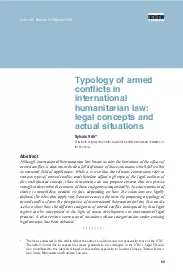

Volume91Number873March2009TheviewsexpressedinthisarticlereflecttheauthorsopinionsandnotnecessarilythoseoftheICRCTheauthorwouldliketoexpresshissinceregratitudetohiscolleaguesintheICRCsLegalDivisionwhoc ID: 881531
Download Pdf The PPT/PDF document "Typologyofarmedconflictsinhumanitarianla..." is the property of its rightful owner. Permission is granted to download and print the materials on this web site for personal, non-commercial use only, and to display it on your personal computer provided you do not modify the materials and that you retain all copyright notices contained in the materials. By downloading content from our website, you accept the terms of this agreement.
1 Typologyofarmedconflictsinhumanitarianla
Typologyofarmedconflictsinhumanitarianlaw:legalconceptsandactualsituationsSylvainViteSylvainViteislegaladvisorintheLegalDivisionoftheInternationalCommitteeoftheRedCross.Althoughinternationalhumanitarianlawhasasitsaimthelimitationoftheeffectsofarmedconflict,itdoesnotincludeafulldefinitionofthosesituationswhichfallwithinitsmaterialfieldofapplication.Whileitistruethattherelevantconventionsrefertovarioustypesofarmedconflictandthereforeaffordaglimpseofthelegaloutlinesofthismultifacetedconcept,theseinstrumentsdonotproposecriteriathatarepreciseenoughtodeterminethecontentofthosecategoriesunequivocally.Acertainamountofclarityisnonethelessneeded.Infact,dependingonhowthesituationsarelegally Volume91Number873March2009 *TheviewsexpressedinthisarticlereflecttheauthorsopinionsandnotnecessarilythoseoftheICRC.TheauthorwouldliketoexpresshissinceregratitudetohiscolleaguesintheICRCsLegalDivisionwhocontributedtotheideasdevelopedinthisarticle,especiallytoLaurentColassis,TristanFerraro,Jean-MarieHenckaertsandKathleenLawand. Althoughinternationalhumanitarianlawhasasitsaimthelimitationoftheeffectsofarmedconflict,itdoesnotincludeafulldefinitionofthosesituationsthatfallwithinitsmaterialfieldofapplication.Whileitistruethattherelevantconventionsrefertovarioustypesofarmedconflictandthereforeaffordaglimpseofthelegaloutlinesofthismultifacetedconcept,theseinstrumentsdonotproposecriteriathatarepreciseenoughtodeterminethecontentofthosecategoriesunequivocally.Acertainamountofclarityisnonethelessneeded.Infact,dependingonhowthesituationsarelegallydefined,therulesthatapplyvaryfromonecasetothenext.Thelegalregimesthatneedtobetakenintoaccountarethusnotalwaysthesameanddependonwhetherthesituationsconstitute,forexample,aninternationaloranon-internationalarmedconflict.Similarly,someformsofviolence,referredtoasinternaltensionsorinternaldisturbances,donotreachthethresholdofapplicabilityofinternationalhumanitarianlawandthereforefallwithinthescopeofothernormativeframeworks.Thisarticleproposesatypologyofarmedconflictsfromtheperspectiveofinternationalhumanitarianlaw.Itsetsout,first,toshowhowthedifferentcat-egoriesofarmedconflictanticipatedbythatlawcanbeinterpretedinthelightofrecentdevelopmentsininternationallegalpractice.Inthatrespect,itisappropriatetorefertotheconceptualizationeffortsrelatingfirstlytothelawofinternationalarmedconflictandsecondlytothelawofnon-internationalarmedconflict.Thisarticlethengoesontoexaminevariouscontroversialcasesofapplication.Therealityofarmedconflictisactuallymorecomplexthanthemodeldescribedininternationalhumanitarianlawtotheextentthattodaysomeobserversquestiontheadequacyofthelegalcategories.ThelawofinternationalarmedconflictThehistoryofthelawofinternationalarmedconflictshowsthatthefieldofap-plicationofthislegalregimehasbeenprogressivelyextendedastreatylawdevel-oped.Whereasanarrowformalisticconceptofwarwaspredominantinitially,thereformofthesystemwiththerev
2 isionoftheGenevaConventionsin1949gavepre
isionoftheGenevaConventionsin1949gaveprecedencetoabroaderapproach,basedonthemoreobjectiveconceptofarmedconflict.Moreover,thatextensionwassubsequentlytakenupwiththeadoptionofAdditionalProtocolIin1977.Thatinstrumentaddedanothertypeofconflicttothefieldofthelawofinternationalarmedconflict,thatofwarsofnationalliber-ation.Thislegalregimealsocomprisesaspecificbodyofruleswhosefieldofap-plicationisdeterminedonthebasisofanautonomousconcept,thatofoccupation.WarandinternationalarmedconflictByvirtueofcommonArticle2(1),the1949GenevaConventionsapplytoallcasesofdeclaredwarorofanyotherarmedconflictwhichmayarisebetweentwoor S.Vite´Typologyofarmedconflictsininternationalhumanitarianlaw:legalconceptsandactual moreoftheHighContractingParties,evenifthestateofwarisnotrecognizedbyoneofthem.ThesituationsreferredtohereareconflictsbetweenStates.TheHighContractingPartiesmentionedinthistextaresovereignentities.Dependingonthecaseinquestion,thesesituationsmaytaketheformofadirectconflictbetweenStatesorofinterventioninapreviouslyexistinginternalconflict.Inthelatterhypothesis,theconflictisinternationalized.ThatisthecaseifaforeignPowersendstroopsintoaterritorytosupportamovementopposingthelocalgovernment.InterventionmayalsotakeplacebyproxywhenthatPowermerelysupportsandguidestheuprisingfromadistance.Inthatcase,itisthenvitaltodeterminethelevelofcontrolthatmakesitpossibletoclassifythearmedconflictasinternational.Noteveryformofinfluencenecessarilyleadstotheconflictbecom-inginternationalized.Onthatpoint,theInternationalCriminalTribunalfortheformerYugoslavia(ICTY)pointedoutthatcontrolbyaStateoversubordinatearmedforcesormilitiasorparamilitaryunitsmaybeofanoverallcharacter(andmustcomprisemorethanthemereprovisionoffinancialassistanceormilitaryequipmentortraining).Thisrequirement,however,doesnotgosofarastoincludetheissuingofspecificordersbytheState,oritsdirectionofeachindividualoper-ThecriterionofoverallcontrolisachievedwhentheforeignStatehasaroleinorganising,co-ordinatingorplanningthemilitaryactionsofthemilitarygroup,inadditiontofinancing,trainingandequippingorprovidingoperationalsupporttothatgroup(emphasisadded).Involvementmustthereforegobeyondmerelogisticalsupport,butthatinvolvementdoesnotimplythateverythingdonebythegroupconcernedisdirectedbytheStatetakingpartfromadistance.ThesituationsreferredtoinArticle2(1)commontothe1949GenevaConventionsareviewedfromthetwinviewpointsofformalismandeffectiveness.1Thesamefieldofapplicationwasalsoretainedforotherinstrumentsofinternationalhumanitarianlaw,inparticularAdditionalProtocolI(seeArt.1(3)).2InternationalCriminalTribunalfortheformerYugoslavia(ICTY),,CaseNo.IT-94-1-A,Judgment(AppealsChamber),15July1999,para84:ItisindisputablethatanarmedconflictisinternationalifittakesplacebetweentwoormoreStates.Inaddition,incaseofaninternalarmedconflictbreakingoutontheterritoryofaState,itmaybecomeinternational(or,dependinguponthecircumstances,beint
3 ernationalincharacteralongsideaninternal
ernationalincharacteralongsideaninternalarmedconflict)if(i)anotherStateintervenesinthatconflictthroughitstroops,oralternativelyif(ii)someoftheparticipantsintheinternalarmedconflictactonbehalfofthatotherState.,para137.Onthispoint,seealsoInternationalCourtofJustice(ICJ),ApplicationoftheConventiononthePreventionandPunishmentoftheCrimeofGenocide(BosniaandHerzegovinaSerbiaand,Judgment,ICJReports2007,26February2007,para404.Withoutadoptingadefinitivepositiononthematter,theCourtacceptedthatthecriterionofoverallcontrolmaybeapplicableandsuitableasameansofdeterminingwhetherornotanarmedconflictisinternational.Foradiscussionofthisissue,seeA.Cassese,TheTestsRevisitedinLightoftheICJJudgmentonGenocideinBosnia,EuropeanJournalofInternationalLaw,Vol.18,No.4,2007,pp.649668.4ICTY,,Judgment(AppealsChamber),abovenote2,para137;seealsoparas120and131.SeealsoICTY,,CaseNo.IT-98-34-T,Judgment(TrialChamber),31March2003,para198.Forananalysisofthiscaselaw,seeJ.G.Stewart,TowardsaSingleDefinitionofArmedConflictinInternationalHumanitarianLaw:aCritiqueofInternationalizedArmedConflict,InternationalReviewoftheRedCross,Vol.85,No.850,pp.323ff.;A.Cullen,TheConceptofNon-InternationalArmedConflictinInternationalHumanitarianLaw:AStudyonThresholdsofApplicabilityThesis,UniversityCollege,Galway,2007,pp.229ff. Volume91Number873March2009 First,therearedeclaredwars,implyingthatthestateofwarisrecognizedofficiallybythepartiesconcerned.Second,thereareotherformsofinter-Statearmedcon-flict,whoseexistencedoesnotdependonhowthepartiesdefinethem.Whiletheconceptofwaralreadyexistsintheoldesttreatiesofinternationalhumanitarianthe1949Conventionsintroducedtheconceptofarmedconflictintothislegalregimeforthefirsttime.Throughthissemanticcontribution,thosewhodraftedthoseinstrumentswantedtoshowthattheapplicabilityofinternationalhumani-tarianlawwashenceforthtobeunrelatedtothewillofgovernments.Itwasnolongerbasedsolelyonthesubjectivityinherentintherecognitionofthestateofwar,butwastodependonverifiablefactsinaccordancewithobjectivecriteria.Thankstothatcontributionin1949,internationalarmedconflictthusbecameestablishedasaconceptgovernedbytheprincipleofeffectiveness.Therelevantrulesapplywhencertainspecificfactualconditionsaremet.Asforthenatureofthoseconditions,itisgenerallyacknowledgedthatitmustbeevaluatedfreely,asthelevelofintensityrequiredforaconflicttobesubjecttothelawofinternationalarmedconflictisverylow.Situationsenvisagedbytherelativeinstrumentsmerelyneedtoexist.ThusassoonasthearmedforcesofoneStatefindthemselveswithwoundedorsurrenderingmembersofthearmedforcesorciviliansofanotherStateontheirhands,assoonastheydetainprisonersorhaveactualcontroloverapartoftheterritoryoftheenemyState,thentheymustcomplywiththerelevantconvention.Itis,however,notnecessaryfortheconflicttoextendovertimeorforittocreateacertainnumberofvictims.Inotherwords,aninternationalarmedconflictexists,asrecalledbytheICTY,wheneverthereisares
4 orttoarmedforcebetweenStates.Tobemorepr
orttoarmedforcebetweenStates.Tobemoreprecise,itmightbesaidthatthatisthecasewhenthecircumstancesarecharacterizedbyhostilitybetweentheparties.Theattackmustbemotivatedbytheintentiontoharmtheenemy,thus5See,forexample,Arts.4,5and6oftheConventionfortheAmeliorationoftheConditionoftheWoundedinArmiesintheFieldof22August1864.6SeeJ.Pictetetal.GenevaConventionIfortheAmeliorationoftheConditionoftheWoundedandSickinArmedForcesintheField:Commentary,Geneva,ICRC,1952,p.32;R.Kolb,Iusinbello,Ledroitinternationaldesconflitsarme,Basel/Brussels,HelbingandLichtenhahn/Bruylant,2003,pp.72ff.7J.Pictetetal.(eds),abovenote6,p.34;seealsoD.Schindler,TheDifferentTypesofArmedConflictsAccordingtotheGenevaConventionsandProtocols,TheHagueAcademyCollectedCourses,Vol.63,1979-II,p.131;H.-P.Gasser,InternationalHumanitarianLaw:anIntroduction,separateprintfromHumanityforAll:theInternationalRedCrossandRedCrescentMovement,HenriDunantInstitute,Geneva,1993,p.24;E.David,Principesdedroitdesconflitsarme,Bruylant,Brussels,2008,p.122;Kolb,abovenote6,p.73.8H.-P.Gasser,abovenote7,pp.2223.9Someauthorsargue,however,thatadistinctionmustbeestablishedbetweeninternationalarmedcon-flict(reachingacertainlevelofintensity)andotherformsofhostileactionsamountingtoincidents,borderclashesorskirmishesonly.SeeInternationalLawAssociation,DraftReport,InitialReportontheMeaningofArmedConflictinInternationalLaw,RiodeJaneiroConference,2008,pp.910and2324.10ICTY,.Tadic,CaseNo.IT-94-1,DecisionontheDefenceMotionforInterlocutoryAppealonJurisdiction,2October1995,para70.SeealsoICTY,.Mucicetal.(CiCamp),CaseNo.IT-96-21,Judgment(TrialChamber),16November1998,para184:lerecoursalaforcearmeeentretatssuffitensoiaclencherlapplicationdudroitinternationalhumanitaire.Thisdefinitionhassincebeentakenupbyotherinternationalbodies.Seeforexample:CommissionofInquiryonLebanon,ReportpursuanttoHumanRightsCouncilresolutionS-2/1,A/HRC/3/2,23November2006,para51. S.Vite´Typologyofarmedconflictsininternationalhumanitarianlaw:legalconceptsandactual rulingoutcasesinwhichtheuseofforceistheresultofanerror(involuntaryincursionintoforeignterritory,wronglyidentifyingthetarget,etc.).Similarly,aninternationalarmedconflictdoesnotexistwhenthetargetedStatehasgivenitsconsentforathirdStatetotakeactioninitsterritory(forexample,tofightanon-governmentalarmedgroup).SincetheadoptionofAdditionalProtocolIof1977,thefieldofapplicationofthelawofinternationalarmedconflicthasceasedtobelimitedtointer-Statestrictosensuandalsoencompassesconflictsbetweengovernmentforcesandsomenon-governmentalgroups,i.e.peoplesfightingintheexerciseoftheirrightofself-determination.TheProtocolstipulatesthatthesituationstargetedbyArticle2commontothe1949GenevaConventionsincludearmedconflictsinwhichpeoplesarefightingagainstcolonialdominationandalienoccupationandagainstracistregimesintheexerciseoftheirrightofself-determination,asen-shrinedintheCharteroftheUnitedNationsandtheDeclara
5 tiononPrinciplesofInternationalLawconcer
tiononPrinciplesofInternationalLawconcerningFriendlyRelationsandCo-operationamongStatesinaccordancewiththeCharteroftheUnitedNations.Thescopeofthisprovisionraisesanumberofquestionsofinterpretation,beginningwiththeprecisedefinitionofthepeoplesconcernedandthecriteriawhichmakeitpossibletodistinguishthosesituationsofarmedconflictfromthatcoveredbyArticle3commontothe1949GenevaConventionsandtheirAdditionalProtocolII.ThetwoinstrumentsreferredtoinArticle1(4)ofAdditionalProtocolIareactuallycouchedintermsthataretoogeneraltoallowfullysatisfactoryanswerstobederivedfromthem.Moreover,itisdifficulttofindadditionalclarificationinactualpracticebecausethescenarioreferredtointhatArticlehasneverbeenofficiallyrecognized,particularlyastheStatesthatmightbeconcerneddidnotratifyAdditionalProtocolI.Theinterestedreadercanmakeusefulreferencetothecommentariesalreadydevotedtothatparticulartypeofarmedconflict.Whenoneofthebelligerentssucceedsingainingtheupperhandoverhisadver-sary,aninternationalarmedconflictmaytaketheformofoccupation.InthewordsofArticle42ofthe1907HagueRegulations,territoryisconsideredoccupied11Fortheoppositeview,seeDavid,abovenote7,p.127.12AdditionalProtocolI,Art.1(4).13Seethesectiononthelawofnon-internationalarmedconflictsbelow.SeealsoM.Bothe,K.J.Partsch,W.A.Solf,NewRulesforVictimsofArmedConflicts,MartinusNijhoff,TheHague,1982,pp.4552.14See,inparticular,D.Schindler,abovenote7,pp.133144;Y.Sandozetal.(eds),CommentaryontheAdditionalProtocolsof8June1977totheGenevaConventionsof12August1949,ICRC/MartinusNijhoff,Geneva/TheHague,1987,paras66118;E.David,abovenote7,pp.184198.15Foramoredetailedstudyofthenotionandthelawofoccupation,seeY.Dinstein,TheInternationalLawofBelligerentOccupation,CambridgeUniversityPress,Cambridge,2009;R.Kolb,S.ViteLedroitdeloccupationmilitaire:perspectiveshistoriquesetenjeuxjuridiquesactuels,Bruylant,Brussels,2009;Y.Arai-Takahashi,TheLawofOccupation:ContinuityandChangeofInternationalHumanitarianLaw,anditsInteractionwithInternationalHumanRightsLaw,MartinusNijhoff,TheHague,2009. Volume91Number873March2009 whenitisactuallyplacedundertheauthorityofthehostilearmy(ouremphasis).Foroccupationinthemeaningofthisprovisiontoexist,twoconditionsmustbefulfilled:(a)theoccupierisabletoexerciseeffectivecontroloveraterritorythatdoesnotbelongtoit;(b)itsinterventionhasnotbeenapprovedbythelegitimateEffectiveterritorialcontrol,whichisattheheartoftheconceptofoccupation,impliesthatasubstitutionofpowersmaytakeeffect.Thatconditionisfulfilledwhen,first,theoverthrowngovernmentisunabletoexerciseitsauthorityand,second,theoccupyingPowerisinapositiontofillthatgapbyexertingitsownThisconditionimpliesinprinciplethatenemytroopsshouldbedeployedintheterritoryconcernedandsucceedinimposingtheminimumstabilitythatwillallowthemtoexercisetheirresponsibilitiesderivingfromthelawofoccupation.Asforthesecondcriterion,theabsenceofconsent,itmustbeunderstoodinfairlybroadterms.Inpartic
6 ular,itisnotlimitedtocasesinwhichpoweris
ular,itisnotlimitedtocasesinwhichpowerisseizedasaresultofhostilities.Article2(2)oftheFourthGenevaConventionof1949com-plementsthe1907definitionbyclarifyingthattherelevantrulesapplyeveniftheoccupationmeetswithnoarmedresistance.Insomecases,territorialcontrolisnotexerciseddirectlybytheoccu-pationforcesbutviaapuppetgovernmentoranotherformofsubordinatelocalHowever,itisdifficulttoevaluateonacase-by-casebasisthedegreeofinfluencerequiredforthisscenariotoactuallyconstituteoccupation,asanyin-terferenceintheaffairsofathirdStatedoesnotnecessarilymeanthatoccupationexists.Relationsbetweenthelocalauthoritiesandtheforeignforcesvaryinin-tensitydependingonthecircumstancesandalwaysrevealacertainreciprocalinfluenceorevenadegreeofconsultationinthedecision-makingprocess.Toresolvethisquestion,theICTYretainsinthiscase,toothecriterionofoverallOccupationexistswhenaStatehasoverallcontrolofthelocalagentsactuallyexercisingeffectivecontrolovertheterritoryinquestion.Thisis,forexample,thepatternofthepresentsituationinNagorno-Karabakh.Azerbaijanhasnolongerbeenabletoexerciseitssovereigntyinthatareasincethewarwithits16See,inparticular:M.Bothe,BeginningandEndofOccupation,CurrentChallengestotheLawofOccupation,ProceedingsoftheBrugesColloquium,2021October2005,No.34,Autumn2004,pp.2832.SeealsoE.Benvenisti,TheInternationalLawofOccupation,PrincetonUniversityPress,Princeton,1993,p.4.Theauthordefinesoccupationastheeffectivecontrolofpower(beitoneormorestatesoraninternationalorganisation,suchastheUnitedNations)overaterritorytowhichthatpowerhasnosovereigntitle,withoutthevolitionofthesovereignofthatterritory.17See,inparticular,UnitedKingdomMinistryofDefence,TheManualoftheLawofArmedConflictOxfordUniversityPress,Oxford,2004,para11.3;ICJ,CaseconcerningArmedActivitiesontheTerritoryoftheCongo(DemocraticRepublicoftheCongo,Judgment,ICJReports2005,para173;ICTY,,abovenote4,para217;A.Roberts,WhatisMilitaryOccupation?,YearbookofInternationalLaw,Vol.55,1984,pp.249and300.18SeeUnitedKingdomMinistryofDefence,abovenote17,para11.3.1.SeealsoICTY,.TadicCaseNo.IT-94-1-T,Judgment(TrialChamber),7May1997,para584:therelationshipofdefactoorgansoragentstotheforeignPowerincludesthosecircumstancesinwhichtheforeignPoweroccu-piesoroperatesincertainterritorythroughtheactsoflocaldefactoorgansoragents(ouremphasis).19ICTY,,CaseNo.IT-95-14-T,Judgment(TrialChamber),3March2000,para149;,abovenote4,paras181188,197202. S.Vite´Typologyofarmedconflictsininternationalhumanitarianlaw:legalconceptsandactual secessionistforces(supportedbytheArmenianarmy)whichendedinitsdefeatin1994.Thatterritoryisgovernedinpractice(effectiveterritorialcontrol)bythegovernmentoftheNagorno-KarabakhRepublic,asitproclaimeditselfon6January1992followingalocallyheldreferendum.Todate,however,noStatehasrecognizedthesovereigntyofthenewauthority.Moreover,severalaspectsindicatethattherepublicisactuallyinarelationofsubordinationtoArmenia(
7 overallcontrol).Themilitarystructuresint
overallcontrol).Themilitarystructuresintheregioninclude,inparticular,asizeablenumberofconscriptsandofficersfromthatcountry.TheroleofArmeniaisnotthereforerestrictedtomerelogisticsupportbutimpliesthatithasahandintheorganization,co-ordinationandplanningofthepowerestablishedinNagorno-Karabakh.Itmaybethereforeconsideredthatthatterritoryisdefactoinasituationofoccupation.Therefore,thetestthatdetermineswhetherthesituationisoneofoccupationbyproxy,namelythatofoverallcontrol,isthesameasthetestthatneedstobecarriedouttodeterminewhetheraninternalconflictisinter-nationalized.Inbothsituations,itisacaseofevaluatingtheintensityofthecontrolexercisedbyaStateoveragrouporauthorityintheterritoryofanotherState.Thelawofnon-internationalarmedconflictTheconceptofnon-internationalarmedconflictinhumanitarianlawmustbeanalysedonthebasisoftwomaintreatytexts:Article3commontothe1949GenevaConventionsandArticle1ofAdditionalProtocolIIof1977.Thissectionwillshedlightonthecriteriaineachoftheseprovisionsandwillshowhowthesecriteriamaybeinterpretedinthelightofpractice.Moreover,theconceptofnon-internationalarmedconflictisdiscussedinconnectionwiththedeterminationofthejurisdictionoftheInternationalCriminalCourt(ICC).ItisappropriatetoreferbrieflytothetermsofthatdiscussionbyexaminingtherelevantprovisionsoftheCourtsStatute.Article3commontothe1949GenevaConventionsArticle3commontothe1949GenevaConventionsappliesinthecaseofarmedconflictnotofaninternationalcharacteroccurringintheterritoryofoneoftheHighContractingParties.Thisprovisionbeginswithanegativeexpression,dealingwitharmedconflictnotofaninternationalcharacter.ItthusrefersbackimplicitlytocommonArticle2,which,asstatedabove,dealswithconflictsbetweenStates.Armedcon-flictsthatarenotofaninternationalcharacterarethoseinwhichatleastoneofthepartiesinvolvedisnotgovernmental.Dependingonthecaseinquestion,hostilities20See,inparticular:UnitedNationsSecurityCouncil,Res.884,12November1993;UnitedNationsGeneralAssembly,Res.62/243,14March2008;CouncilofEuropeParliamentaryAssembly,Res.141621CommonArticle3(1). Volume91Number873March2009 takeplaceeitherbetweenone(ormore)armedgroup(s)andgovernmentforcesorsolelybetweenarmedgroups.CommonArticle3alsoassumesthatanarmedconflictexists,i.e.thatthesituationreachesalevelthatdistinguishesitfromotherformsofviolencetowhichinternationalhumanitarianlawdoesnotapply,namelysituationsofinternaldis-turbancesandtensions,suchasriots,isolatedandsporadicactsofviolenceandotheractsofasimilarnature.Thethresholdofintensityrequiredinthatcaseishigherthanforaninternationalarmedconflict.Actualpractice,inparticularthatoftheICTY,revealsthatthisthresholdisreachedeverytimethatthesituationcanbedefinedasprotractedarmedviolence.Thisconditionneedstobeassessedagainsttheyardstickoftwofundamentalcriteria:(a)theintensityoftheviolenceand(b)theorganizationoftheparties.Thesetwocomponentsoftheconceptofnon-internationalarmedconflictcannotbedescrib
8 edinabstracttermsandmustbeevaluatedonaca
edinabstracttermsandmustbeevaluatedonacase-by-casebasisbyweighingupahostofindicativedata.regardtothecriterionofintensity,thesedatacanbe,forexample,thecollectivenatureofthefightingorthefactthattheStateisobligedtoresorttoitsarmyasitspoliceforcesarenolongerabletodealwiththesituationontheirown.Thedur-ationoftheconflict,thefrequencyoftheactsofviolenceandmilitaryoperations,thenatureoftheweaponsused,displacementofcivilians,territorialcontrolbyoppositionforces,thenumberofvictims(dead,wounded,displacedpersons,etc.)arealsopiecesofinformationthatmaybetakenintoaccount.However,theseare22SeeICTY,.Tadic,DecisionontheDefenceMotionforInterlocutoryAppealonJurisdiction,abovenote10,para70.23AdditionalProtocolII,Art.1(2).AlthoughthisquoteistakenfromAdditionalProtocolII,itisacceptedthatthethresholdestablishedisalsovalidforconflictscoveredbycommonArt.3.SeeICRC,HowisthetermArmedConflictdefinedininternationalhumanitarianlaw?,OpinionPaper,March2008,p.3.SeealsoICTY,,CaseNo.IT-03-66-T,Judgment(TrialChamber),30November2005,para84.24ICTY,,DecisionontheDefenceMotionforInterlocutoryAppealonJurisdiction,abovenote10,para70.25SeeICTY,,Judgment(TrialChamber),abovenote18,para561568,especiallypara562.SeealsoICTY,,abovenote23,para84;ICTY,,CaseNo.IT-04-82,Judgment(TrialChamber),10July2008,para175.Thesecriteriahavesincebeentakenupbyotherinternationalbodies.See,inparticular,InternationalCriminalTribunalforRwanda(ICTR),,CaseNo.ICTR-96-3,Judgment(TrialChamberI),6December1999,para93;InternationalCommissionofInquiryonDarfur,ReportPursuanttoSecurityCouncilResolution1564of18September2004,25January2005,para7476.Inthecase,theICTYadoptedaslightlydifferentposition,statingthatthenotionofprotractedarmedviolencemustthereforebeunderstoodbroadly.Itdoesnotcoverthedurationoftheviolenceonly,butalsocoversallaspectsthatwouldenablethedegreeofintensitytobeevaluated.TheICTYalsoseemstoequatethisnotionwiththatofintensity.(ICTY,,CaseNo.IT-04-84-T,Judgment(TrialChamber),3April2008,para49.Foradoctrinalconsiderationofthispoint,seeA.Cullen,abovenote4,pp.179ff.26ICTY,,abovenote25,para49;ICTR,,abovenote25,para93.InhisCommentaryontheGenevaConventions,Pictetsuggests,bywayofindication,aseriesofcriteriathatmaybetakenintoaccountinthisevaluation(seePictet,abovenote6,pp.4950).27SeeR.Pinto(rapporteur),ReportoftheCommissionofexpertsforthestudyofthequestionofaidtothevictimsofinternalconflicts,InternationalReviewoftheRedCross,February1963,especiallypp.8283:Theexistenceofanarmedconflict,withinthemeaningofarticle3,cannotbedeniedifthehostileaction,directedagainstthelegalgovernment,isofacollectivecharacterandconsistsofaminimumamountoforganisation.Inthisrespectandwithoutthesecircumstancesbeingnecessarilycumulative, S.Vite´Typologyofarmedconflictsininternationalhumanitarianlaw:legalconceptsandactual assessmentfactorsthatmakeitpossibletostatewhetherthethresholdofintensityhasbeenreachedineachcase;theyarenotconditionstha
9 tneedtoexistcon-currently.Asforthesecond
tneedtoexistcon-currently.Asforthesecondcriterion,thoseinvolvedinthearmedviolencemusthaveaminimumleveloforganization.Withregardtogovernmentforces,itispresumedthattheymeetthatrequirementwithoutitbeingnecessarytocarryoutanevaluationineachcase.Asfornon-governmentalarmedgroups,theindicativeelementsthatneedtobetakenintoaccountinclude,forexample,theexistenceofanorganizationalchartindicatingacommandstructure,theauthoritytolaunchoperationsbringingtogetherdifferentunits,theabilitytorecruitandtrainnewcombatantsortheexistenceofinternalrules.Whenoneorotherofthesetwoconditionsisnotmet,asituationofviolencemaywellbedefinedasinternaldisturbancesorinternaltensions.Thesetwoconcepts,whichdesignatetypesofsocialinstabilitythatdonotpertaintoarmedconflict,haveneverbeendefinedinlaw,despitethefactthattheyarere-ferredtoexplicitlyinAdditionalProtocolII.Initsbackgrounddocumentsinpreparationforthedraftingofthatinstrument,theICRCconsideredthatinternaldisturbancesaresituationsinwhichthereisnonon-internationalarmedconflictassuch,butthereexistsaconfrontationwithinthecountry,whichischaracterizedbyacertainseriousnessordurationandwhichinvolvesactsofviolence.Theselattercanassumevariousforms,allthewayfromthespontaneousgenerationofactsofrevolttothestrugglebetweenmoreorlessorganizedgroupsandtheauthoritiesinpower.Inthesesituations,whichdonotnecessarilydegenerateintoopenstruggle,theauthoritiesinpowercalluponextensivepoliceforces,orevenarmedforces,torestoreinternalorder.Asforinternaltensions,theycoverlessviolentcircumstancesinvolving,forexample,massarrests,alargenumberofpoliticaldetainees,tortureorotherkindsofill-treatment,forceddisappearanceand/orthesuspensionoffundamentaljudicialoneshouldtakeintoaccountsuchfactorsasthelengthoftheconflict,thenumberandframeworkoftherebelgroups,theirinstallationoractionapartoftheterritory,thedegreeofinsecurity,theexistenceofvictims,themethodsemployedbythelegalgovernmenttore-establishorder,etc.ForareviewoftheindicativefactorstakenintoaccountbytheICTYinitscaselaw,seeICTY,,abovenote25,para177.SeealsoICTY,,abovenote23,para168;ICTY,,abovenote25,para49.28ICTY,,abovenote25,para60.29ForareviewoftheindicativefactorstakenintoaccountbytheICTYinitscaselaw,seeICTY,,abovenote25,paras199203.SeealsoICTY,,abovenote23,paras94134;ICTY,,abovenote25,para60.30AdditionalProtocolII,Art.1(2).31ICRC,ProtectionofVictimsofNon-InternationalArmedConflicts,DocumentpresentedattheConferenceofgovernmentexpertsonthereaffirmationanddevelopmentofinternationalhumanitarianlawappli-cableinarmedconflicts,Vol.V,Geneva,24May12June1971,p.79.ThisdefinitionwasalsotakenupintheCommentaryontheAdditionalProtocols:seeY.Sandozetal.(eds),abovenote14,para4475.32Y.Sandozetal.(eds),abovenote14,para4476.Forafurtherreviewofinternaldisturbancesandinternaltensions,seeespeciallyA.Eide,InternalDisturbancesandTensions,InternationalDimensionsofHumanitarianLaw,UNESCO,Paris,1988,pp.279295;H.-P.Gasser,Hu
10 manitarianStandardsforInternalStrifeABr
manitarianStandardsforInternalStrifeABriefReviewofNewDevelopments,InternationalReviewoftheRedCross,No.294,MayJune1993,pp.221226;F.NiAolain,TheRelationshipbetweenSituationsofEmergencyand Volume91Number873March2009 Lastly,commonArticle3appliestoarmedconflictsoccurringintheter-ritoryofoneoftheHighContractingParties.Themeaningofthiselementmaybecontroversial.Isittobeunderstoodasaconditionexcludingnon-internationalarmedconflictstakingplaceintwoorevenmoreStateterritories,orratherasasimplereminderofthefieldofapplicationofcommonArticle3?Accordingtothelatterhypothesis,itisarguedthatthisspecificpointwasincludedinordertomakeitclearthatcommonArticle3mayonlybeappliedinrelationtotheterritoryofStatesthathaveratifiedthe1949GenevaConventions.Weshallgoontoseethatitisprobablybesttotendtowardsthatinterpretation.Someobserversaddafurtherconditiontothenotionofnon-internationalarmedconflict.Theysuggestthataccountneedstobetakenofthemotivesofthenon-governmentalgroupsinvolved.Thistypeofconflictwouldthuscoveronlygroupsendeavouringtoachieveapoliticalobjective.Purelycriminalorganiza-tionssuchasmafiagroupsorterritorialgangswouldthusbeeliminatedfromthatcategoryandcouldinnowaythenbeconsideredaspartiestoanon-internationalarmedconflict.However,inthecurrentstateofhumanitarianlaw,thisadditionalconditionhasnolegalbasis.TheICTYhadoccasiontorecallthiswhenconsideringthenatureofthefightingthattookplacein1998betweenSerbianforcesandtheKosovoLiberationArmy(UCK).Inthecase,thedefencehadchallengedtheideathatthefightingcouldconstituteanarmedconflict,arguingthattheopera-tionscarriedoutbytheSerbianforceswerenotintendedtodefeattheenemyarmybuttocarryoutethniccleansinginKosovo.TheTribunalrejectedthatargumentbypointingout,inparticular,thatthedeterminationoftheexistenceofanarmedconflictisbasedsolelyontwocriteria:theintensityoftheconflictandorganizationoftheparties,thepurposeofthearmedforcestoengageinactsofviolenceoralsoachievesomefurtherobjectiveis,therefore,irrelevant(ouremphasis).Thereversepositionwould,moreover,raiseproblemsthatitwouldbedifficulttoresolveinpractice.Themotivesofarmedgroupsareneveruniformandcannotalwaysbeclearlyidentified.Manyofthemoftencarryoutcriminalactivitiessuchasextortionordrug-trafficking,whileatthesametimepursuingapoliticalobjective.Conversely,onoccasioncriminalorganizationsalsoexerciseapowerpertainingtothepoliticalsphereorattheveryleasttothemanagementofLow-IntensityArmedConflict,IsraelYearbookonHumanRights,Vol.28,1998,pp.97106;R.Abi-Saab,Ledroithumanitaireetlestroublesinternes,LiberAmicorumGeorgesAbi-Saab,MartinusNijhoff,TheHague,2001,pp.477493.33SeethesubsectiononExportednon-internationalarmedconflictsbelow.34Bruderleinretains,forexample,threemaincharacteristicsforthedefinitionofanarmedgroup,i.e.(a)abasiccommandstructure;(b)recoursetoviolenceforpoliticalends;(c)independencefromStatecontrol(C.Bruderlein,TheRoleofNon-stateActorsinBuildingHumanSecuri
11 ty:ThecaseofArmedGroupsinIntra-stateWars
ty:ThecaseofArmedGroupsinIntra-stateWars,CentreforHumanitarianDialogue,Geneva,May2000).SeealsoD.Petrasek,EndsandMeans:HumanRightsApproachestoArmedGroups,InternationalCouncilonHumanRightsPolicy,Geneva,2000,p.5.35ICTY,,abovenote23,para170. S.Vite´Typologyofarmedconflictsininternationalhumanitarianlaw:legalconceptsandactual Article1ofAdditionalProtocolIIAdditionalProtocolIIappliestonon-internationalarmedconflictswhichtakeplaceintheterritoryofaHighContractingPartybetweenitsarmedforcesanddissidentarmedforcesorotherorganizedarmedgroupswhich,underresponsiblecommand,exercisesuchcontroloverapartofitsterritoryastoenablethemtocarryoutsustainedandconcertedmilitaryoperationsandtoimplementthisProtocol.However,thisinstrumentdoesnotapplytowarsofnationalliberation,whichareequatedwithinternationalarmedconflictsbyvirtueofArticle1(4)ofAdditionalProtocolI.AsinthecaseofcommonArticle3,anon-internationalarmedconflictwithinthemeaningofAdditionalProtocolIIcanonlyexistifthesituationattainsadegreeofviolencethatsetsitapartfromcasesofinternaltensionsordisturbances.ThatinstrumentnonethelessdefinesamorelimitedfieldofapplicationthanthatofcommonArticle3.Itrequiresnon-governmentalforcestohaveaparticularlyhighleveloforganization,inthesensethattheymustbeplacedunderresponsiblecommandandexerciseterritorialcontrol,allowingthemtocarryoutsustainedandconcertedmilitaryoperationsandtoimplementthisProtocol.commonArticle3alsopresumesthatarmedgroupsareabletodemonstrateadegreeoforganization,itdoesnotstipulatethatthesegroupsshouldbeabletocontrolpartofaterritory.Inpractice,aconflictmaythereforefallwithinthematerialfieldofapplicationofcommonArticle3withoutfulfillingtheconditionsdeterminedbyAdditionalProtocolII.Conversely,allthearmedconflictscoveredbyAdditionalProtocolIIarealsocoveredbycommonArticle3.Inpractice,itisoftendifficulttoidentifysituationsthatmeetthecriteriaofapplicationestablishedbyAdditionalProtocolII.Therequireddegreeofterri-torialcontrol,inparticular,maybeperceiveddifferentlyfromonecasetoanother.Ifabroadinterpretationisadopted,theconceptofnon-internationalarmedcon-flictwithinthemeaningofthatinstrumentcomesclosetothatofcommonArticle3.EventemporarycontrolthatisgeographicallylimitedwouldsufficeinthatcasetojustifytheapplicationofAdditionalProtocolII.Conversely,ifArticle1(1)isinterpretedstrictly,thesituationscoveredarerestrictedtothoseinwhichthenon-governmentalpartyexercisessimilarcontroltothatofaStateandthenatureoftheconflictissimilartothatofaninternationalarmedconflict.InitsCommentaryontheAdditionalProtocols,theICRCseemstoadoptanintermediatepositionon36AdditionalProtocolII,Art.1(2).37AdditionalProtocolII,Art.1(1).Onthispoint,seeM.Bothe,K.J.Partsch,W.A.Solf,abovenote13,pp.626ff.38MomtazconsidersthatitisnotnecessaryforthepartiesconcernedtosetupanadministrativestructuresimilartothatofaState.Headdsthatthecriterionofterritorialcontrolmustbeevaluatedinaccordancewiththenatureofthee
12 nvisagedobligations.Forsomeofthoseobliga
nvisagedobligations.Forsomeofthoseobligationsthatarerelatedtorespectforfundamentalrights,controlofpartoftheterritorycouldprovetobeunnecessary(D.Momtaz,Ledroitinternationalhumanitaireapplicableauxconflitsarmesnoninternationaux,TheHagueAcademyCollectedCourses,No.292,2002,p.50,ICRCtranslation).39L.Moir,TheLawofInternalArmedConflict,CambridgeUniversityPress,Cambridge,2002,p.106. Volume91Number873March2009 thisissue,acceptingthatterritorialcontrolcansometimesberelative,forexample,whenurbancentresremainingovernmenthandswhileruralareasescapetheirItnonethelessaddsthattheverynatureoftheobligationspresentedinProtocolIIimpliesthatthereissomedegreeofstabilityinthecontrolofevenamodestareaofland.AdditionalProtocolIIalsorestrictsitsfieldofapplicationtoarmedcon-flictbetweengovernmentalforcesanddissidentarmedforcesorotherorganizedarmedgroups.ThatmeansthatcontrarytocommonArticle3,whichdoesnotprovideforthatrestrictionitdoesnotextendtoconflictssolelybetweennon-governmentalgroups.Lastly,AdditionalProtocolIIrepeatstherationelocicriterionalreadyformulatedincommonArticle3,i.e.thatitonlycoversnon-internationalarmedconflictsoccurringintheterritoryofoneoftheHighContractingParties.Thepreviouscommentsonthissubjectalsoapplyhere.TheProtocolalsostipulatesthattheconflictsconcernedarethosetakingplaceontheterritoryofaHighContractingPartybetweenitsarmedforcesandoppositionmovements.Anarrowreadingofthispassagewouldmakethisinstrumentinapplicabletothetroopsofagovernmentinterveningabroadinsupportofthelocalauthorities.TheforcesinvolvedinthatcasearenotthoseoftheStateinwhichtheconflictistakingplace.Aninterpretationinkeepingwiththespiritofhumanitarianlawindicates,how-ever,thattheexpressionitsarmedforcesshouldinthiscasecovernotonlythetroopsoftheterritorialState,butalsothoseofanyotherStateinterveningonbehalfofthegovernment.AsforthescopeofthenewpointsintroducedinAdditionalProtocolII,itshouldberecalledthatthatinstrumentexpandsandsupplementscommonArticle3butthatitdoesnotchangeitsconditionsofapplication.Theadditionalre-strictionsprovidedforinArticle1(1)thereforeonlydefinethefieldofapplicationoftheProtocolanddonotextendtotheentirelawofnon-internationalarmedconflict.CommonArticle3thuspreservesitsautonomyandcoversalargernumberofsituations.TheRomeStatuteoftheInternationalCriminalCourt(ICC)TheRomeStatuteoftheICCdistinguishesbetweentwocategoriesofcrimesthatoccurduringarmedconflictsnotofaninternationalcharacter:(a)seriousviola-tionsofcommonArticle3,and(b)otherseriousviolationsofthelawsandcustomsofwarthatareapplicableinthosesituations.Inbothcases,theStatuteindicatesthelowestlevelofapplicabilityoftherelevantprovisionsbystipulatingthatthey40Y.Sandozetal.(eds),abovenote14,para4467.,para4461;Bothe,PartschandSolf,abovenote13,p.627.43AdditionalProtocolII,Art.1(1).44Y.Sandozetal.(eds),abovenote14,para4454;L.Moir,abovenote39,p.101.45RomeStatuteoftheICC,Art.8(2)(c)and(e),respectively. S.Vit
13 e´Typologyofarmedconflictsininternation
e´Typologyofarmedconflictsininternationalhumanitarianlaw:legalconceptsandactual donotapplytosituationsofinternaldisturbancesandtensions,suchasriots,isolatedandsporadicactsofviolenceandotheractsofasimilarnature.Moreover,whereasthisinstrumentdoesnotgiveamoreprecisedefinitionofthematerialfieldofapplicationoftherulespertainingtoseriousviolationsofcommonArticle3(Article8(2)(d)),itclarifiesthenotionofnon-internationalarmedconflictinthecaseofotherseriousviolations.Article8(2)(f)stipulatesinthatcasethattherulesmustapplytoarmedconflictsthattakeplaceintheterritoryofaStatewhenthereisprotractedarmedconflictbetweengovernmentalauthoritiesandorganizedarmedgroupsorbetweensuchgroups.Thequestionthatthenarisesiswhether,inreferringexplicitlytothecriterionofduration(protractedarmedconflict),paragraph(2)(f)merelyclarifiesthetermsofpara-graph(2)(d),withoutcreatingaseparatecategoryofconflict,orwhetheritpro-posesadifferenttypeofnon-internationalarmedconflict,thusdefininganewfieldofapplication.Thatquestionisthesubjectofcontroversyandhasnotyetbeenfinallyresolved.Someobserversconsiderthatthetwoparagraphsdealwithoneandthesamesituation.Theyconsider,inparticular,thattheintentionofthosenego-tiatingtheStatutewasnottocreateaseparatecategoryofnon-internationalarmedconflict.Rather,thereferencetodurationinparagraph(2)(f)wasintendedtopreventtherestrictivenotioninAdditionalProtocolIIfrombeingincorporatedintotheStatute.Itwas,inaway,anefforttoachieveacompromisebetweentheoriginaldraft,whichmadenodistinctionbetweenparagraphs(2)(d)and(2)(f),andthedesireofsomeStatestoincludetherestrictionsofAdditionalProtocolIIinthatsecondparagraph.Moreover,thosewhomaintainthatpositionclaimthattheirinterpretationistheonlyonethatisinkeepingwiththeevolution46RomeStatuteoftheICC,Arts.8(2)(d)and(f),respectively.47ThisdefinitionisbasedonthecaselawoftheICTY,whichdeemedthatanarmedconflictexistswheneverthereisaresorttoarmedforcebetweenStatesorprotractedarmedviolencebetweengovern-mentalauthoritiesandorganizedarmedgroupsorbetweensuchgroupswithinaState(ICTY,,DecisionontheDefenceMotionforInterlocutoryAppealonJurisdiction,abovenote11,para70(ouremphasis)).48T.Meron,TheHumanizationofHumanitarianLaw,AmericanJournalofInternationalLaw,Vol.94,2000,p.260;M.Bothe,WarCrimes,inA.Casseseetal.TheRomeStatuteoftheInternationalCriminalCourt:ACommentary,OxfordUniversityPress,Oxford,2002,p.423;A.Cullen,TheDefinitionofNon-internationalArmedConflictintheRomeStatuteoftheInternationalCriminalCourt:AnAnalysisoftheThresholdofApplicationContainedinArticle8(2)(f),JournalofConflictandSecurityLaw,Vol.12,No.3,2007,p.445.49Thewordingofparagraph(2)(f)istheoutcomeofaninitiativelaunchedbySierraLeone,theaimofwhichwastoreachacompromisebetweendelegationsinfavourofintroducingalistofwarcrimesapplicabletonon-internationalarmedconflictsandthoseagainstit.Aninitialproposalinthatdirection,submittedbytheBureauoftheCommitteeoftheWhole,c
14 onsistedoflimitingthefieldofapplicationo
onsistedoflimitingthefieldofapplicationofthecrimesinpara(2)(e)bytakingupthecriteriaelaboratedinArt.1(2)ofAdditionalProtocolII(A/CONF.183/C.1/L.59).Asagreementcouldnotbereachedonthatproposal,SierraLeonesuggestedthetextthatwasultimatelyretained.Theaimwastoappeasethedelegationsthatwereopposedtointroducingwarcrimesintothelawofnon-internationalarmedconflict,whileavoidingathresholdashighasthatinAdditionalProtocolII(A/CONF.183/C.1/SR.35,para8).SeeA.Cullen,abovenote48,pp.419445. Volume91Number873March2009 ofcustomarylaw,whichmakesnodistinctionbetweendifferenttypesofnon-internationalarmedconflict.Bycontrast,otherauthorsconsiderthatiftheconceptofnon-internationalarmedconflictinparagraph(2)(d)refersdirectlytothatofcommonArticle3,thenotioninparagraph(2)(f)addsatimecriterion.Anon-internationalarmedconflictwithinthemeaningofparagraph(2)(f)existswhenthatconflictisprotracted.Whereasfromthepointofviewofparagraph(2)(d),durationisafactorthatmayperhapsbetakenintoaccountwhenevaluatingthesituationbutdoesnotconstituteacompulsorycriterion,itisnonethelessanintegralpartoftheveryconceptofparagraph(2)(f).Thisnotiondoesnotthereforeseemtoconstituteanextensionofthefieldofapplicationofparagraph(2)(d)butcreatesaseparatecategoryofnon-internationalarmedconflictwithaviewtocriminalizing,withinthecontextoftheStatuteoftheICC,additionalviolationsofinternationalhumanitarianlaw,i.e.violationsofrulesinAdditionalProtocolII.Theneedtoachieveacompromisewhenpreparingthatprovisionseemstoindicatethattheintentionwastoreachagreementonadifferentcategoryfromthatreferredtoinparagraph(2)(d).Caselawtendstoprovidesupportforthesecondinterpretation.IntheLubangaDyilocase,theICCPre-TrialChamberreferredtoAdditionalProtocolIIinordertointerpretparagraph(2)(f)oftheStatute.Itthusapparentlywantedtoconferadistinctmeaningonthisprovision,definingaspecificthresholdofapplicability.TheChambermadeitclearthatthisthresholdischaracterizedbytwoconditions:(a)theviolencemustachieveacertainintensityandbeprotracted;(b)anarmedgroupwithadegreeoforganization,particularlytheabilitytoplanandcarryoutmilitaryoperationsforaprolongedperiodoftimemustbein-Wordedlikethat,thisdefinitionthereforeseemstodefineafieldofap-plicationthatisstricterthanthatofcommonArticle3,asitrequiresthefightingtotakeplaceoveracertainperiodoftime.Itis,however,broaderthanthatofAdditionalProtocolIIasitdoesnotrequirethearmedgroup(s)concernedtoexerciseterritorialcontrol.ThecategoryofconflicttargetedhereisthereforehalfwaybetweenthecategoriesreferredtoincommonArticle3andinAdditionalProtocolII.50A.Bouvier,M.Sassoli(eds),HowDoesLawProtectinWar?,Vol.1,Geneva,ICRC,2006,p.110;R.Provost,InternationalHumanRightsandHumanitarianLaw,CambridgeUniversityPress,Cambridge,2002,pp.268f.;W.A.Schabas,AnIntroductiontotheInternationalCriminalCourtCambridgeUniversityPress,Cambridge,2007(3rdedn),p.116.SeealsothemorebalancedpositionofE.David,whoconsidersthat,strictlyspeaking,para(2
15 )(f)doesnotcreateathirdcategoryofnon-int
)(f)doesnotcreateathirdcategoryofnon-internationalarmedconflict,butthatbroaderconceptofarmedconflictreplacesthatofAdditionalProtocolIIbywayoflexposterior(David,abovenote7,p.137,ICRCtranslation).51InternationalCriminalCourt,LubangaDyilo,CaseNo.ICC-01/04-01/06-803,Decisionontheconfirmationofcharges(Pre-TrialChamberI),29January2007,paras229237,especially234.52Thisnewcategoryalsoposescertainproblems.Thereisnoobjectivecriterionthatmakesitpossibletostatewhentherequiredminimumdurationisreached.Inaddition,thequestionisraisedofthelegalregimetobeappliedduringtheperiodinwhichthefightingmaynotyetbeconsideredsufficientlyprotractedforittobeclassifiedasanon-internationalarmedconflictwithinthemeaningofthatdefinition.Mustaretroactiveapplicationofinternationalhumanitarianlawbeenvisagedinthatcase? S.Vite´Typologyofarmedconflictsininternationalhumanitarianlaw:legalconceptsandactual Insum,theRomeStatuteoftheICCseemstoidentifytwotypesofnon-internationalarmedconflict:firstly,conflictswithinthemeaningofcommonArticle3(paras(2)(c)(d));andsecondly,protractednon-internationalarmedconflicts(paras(2)(e)(f)).ItshouldnonethelessberecalledthatthisinnovationintheStatutedoesnotcreateanewconceptofnon-internationalarmedconflictininternationalhumanitarianlaw,butsimplyaimsatdeterminingtheICCsjurisdiction.Itthereforeappliesonlytotheexerciseofthatjurisdictionanddoesnotestablishacategorythatismoregenerallyapplicable.ControversialclassificationofcertainarmedconflictsArmedconflictsareinrealitynotasclearlydefinedasthelegalcategories.Someofthemmaynotexactlytallywithanyoftheconceptsenvisagedininternationalhumanitarianlaw.Thisraisesthequestionofwhetherthosecategoriesneedtobesupplementedoradaptedwithaviewtoensuringthatthesesituationsdonotendupinalegalvacuum.Withoutclaimingtobeexhaustive,thischapterwillexaminesomedilemmasencounteredinpracticebyreferringtothreetypesofsituationwhosequalificationsarecontroversial:controlofaterritorywithoutmilitarypresenceontheground;foreigninterventioninnon-internationalarmedconflict;andnon-internationalarmedconflictsontheterritoryofseveralStates.ControlofaterritorywithoutmilitarypresenceonthegroundDespitetheclarificationscontributedbythe1907HagueRegulationsandthe1949GenevaConventiontothenotionofoccupation,itisnotalwayseasyinpracticetoidentifythesituationsthatarecoveredbythatconcept.AsRobertspointsout,thecoremeaningofthetermisobviousenough;butasusuallyhappenswithabstractconcepts,itsfrontiersarelessclear.TheexampleoftheGazaStripfollowingtheIsraeliwithdrawalillustratesthosedifficultieswithparticularacuity.On12September2005,thelastIsraelitroopsfinishedwithdrawingfromthatregioninwhichtheyhadmaintainedacontinuouspresencesincetheSix-DayWarin1967.Indoingso,theywerehelpingtoimplementaDisengagementPlanadoptedbytheIsraeligovernmenton6June2004andendorsedbyparliamenton25Octoberofthatsameyear.Byvirtueofthatplan,theauthoritiesintentionwastoputanendtotheirre
16 sponsibilitiesvis-avisthepeoplelivingint
sponsibilitiesvis-avisthepeoplelivinginthatterritory.Shoulditthereforebeconcludedthatthosemeasuresmarkedtheendoftheoccupationoftheregioninquestion?Inother53Roberts,abovenote17,p.249.54IsraeliPrimeMinistersOffice,CabinetResolutionRegardingtheDisengagementPlan:AddendumRevisedDisengagementPlanMainPrinciples,6June2004,availableathttp://www.mfa.gov.il/MFA/6-June-2004.htm#A(lastvisited9July2009). Volume91Number873March2009 words,wasthephysicalwithdrawaloftheIsraeliforcesenoughtoadmitthateffectiveterritorialcontrolcharacteristicofoccupationdidnotexistanylongeratthattime?Someobserversanswerthatquestioninthenegative.ItwasthusrecalledthatIsraelretainedsubstantialcontrolovertheGazaStrip,althoughitstroopswerenolongerphysicallydeployedinthatarea.TheDisengagementPlanclearlystatedthatIsraelwastocontinuetoexercisecontroloverthebordersofthatterritory,aswellasoveritsairspaceandcoastalregion.Moreover,IsraelhastheadvantageofbeingabletoenterPalestinianterritoryatanytimeinordertomaintainpublicThispowerismadegreaterbythesmallsizeoftheterritoryofGazaandthemilitarymeansavailable.ThatinterpretationwouldalsofindsomesupportinArticle42(2)ofthe1907HagueRegulations,whichmakesitclearthatoccupationexistswhentheauthorityofthehostilearmyhasbeenestablishedandcanbe(ouremphasis).Thatabilitycouldbeinterpretedasmeaningthatpotentialauthoritywouldsufficeasconfirmationoftherealityofoccupation.TheUnitedNationsSecretaryGeneralthusconsideredthattheactionsofIDFinrespectofGazahaveclearlydemonstratedthatmoderntechnologyallowsanoc-cupyingPowertoeffectivelycontrolaterritoryevenwithoutamilitarypresence.Accordingtothatposition,occupationoftheGazaStripwouldthereforenothaveceasedwiththewithdrawaloftroopsin2005,asIsraelcouldbesaidtocontinuetoexercisefromadistanceapowerequivalenttotheeffectivecontrolrequiredunderthelawofoccupation.However,otherobserversconsiderthatacloserstudyofthetreatytextsshowsthattheabilityofanoccupiertoimposeitsauthoritycannotbeseparatedfromitsphysicalpresenceintheterritoryunderitscontrol.WhileArticle42of56SeetheNotebytheUnitedNationsSecretary-General:SituationofhumanrightsinthePalestinianterritoriesoccupiedsince1967,UNDoc.A/61/470,27September2006,para6.SeealsoReportonthesituationofhumanrightsinthePalestinianTerritoriesoccupiedbyIsraelsince1967,J.Dugard,SpecialRapporteur,E/CN.4/2006/29,17January2006,paras6ff.57IsraeliPrimeMinistersOffice,abovenote54,Chapter1:BackgroundPoliticalandSecurity58ForamoredetailedanalysisofthepowersstillbeingexercisedbyIsraelfollowingitswithdrawalfromGaza,seeGishaLegalCenterforFreedomofMovement,DisengagedOccupiers:TheLegalStatusof,January2007,pp.29ff,availableat:http://www.gisha.org/UserFiles/File/Report%20for%20the%20website.pdf(lastvisited13July2009).SituationofhumanrightsinthePalestinianterritoriesoccupiedsince1967,UNDoc.A/61/470,27September2006,para7.SeealsotheReportoftheSpecialRapporteuroftheCommissiononHumanRightsonthesituationofhu
17 manrightsinthePalestinianTerritoriesoccu
manrightsinthePalestinianTerritoriesoccupiedbyIsraelsince19672006/29,17January2006).SeealsoC.Bruderlein,LegalAspectsofIsraelsDisengagementPlanUnderInternationalHumanitarianLaw,LegalandPolicyBrief,HarvardUniversityProgramonHumanitarianPolicyandConflictResearch,November2004,pp.1011;A.Bockel,LeretraitisraeliendeGazaetsesquencessurledroitinternationalAnnuaireFranc¸aisdeDroitInternational,Vol.50,2005,p.23;I.Scobbie,IsGazaStillOccupiedTerritory?,ForcedMigrationReview,Vol.26,2006,p.18.60SeeY.Shany,Faraway,soClose:TheLegalStatusofGazaafterIsraelsDisengagement,TheHebrewUniversityofJerusalemInternationalLawForum,ResearchPaperNo.12-06,August2006,p.19.SeealsoRoberts,abovenote17,p.300;H.-P.Gasser,BelligerentOccupation,inTheHandbookofHumanitarianLawinArmedConflicts,D.Fleck(ed),OxfordUniversityPress,Oxford,1995,p.243;M.Bothe,Occupation,Belligerent,EncyclopediaofPublicInternationalLaw,Vol.3,Elsevier,Amsterdam,1997,p.764. S.Vite´Typologyofarmedconflictsininternationalhumanitarianlaw:legalconceptsandactual the1907HagueRegulationsacceptsthatoccupationexistswhentheadversarysauthoritycanbeexercised,itmakesitclearthatthatauthoritymustfirstbeestablished.Itthusforgesanindissociablelinkbetweentheestablishmentofauthority,implyingthedeploymentofapresenceintheterritoryinquestion,andtheabilitytoextendthatauthoritytotheentireterritory.AswasrecalledbytheInternationalCourtofJustice,effectivecontrolbecomesapparentasaresultofasubstitutionofpowers.Obviously,asimilarthresholdofapplicationcannotbeachievediftheforeignforcesarelocatedoutsidetheregioninquestion.Moreover,itisimpossibletoconceiveoftheimplementationofmostoftherulesofoccupationunlessthereisapresenceintheterritory.Itisactuallyimpossibletoensurepublicorderandlifeinaterritory,asrequiredbyArticle43ofthe1907HagueRegulations,fromoutside.ItwouldthusbeparadoxicaltorequireaStatetofulfilitsinternationalobligationsifitisunabletodosobecauseitisnotpresentintheareaconcerned.Asimilarinterpretationwouldruncountertothebasictenetsofthelawofoccupation.TheexampleofGazashowstowhatextenttheconceptofoccupationposesdifficultiesofinterpretationwhenitcomestoapplyingitinpractice.Itwouldbeimpossiblewithinthelimitedframeworkofthisarticletodealwithalltheissuesassociatedwiththatconcept.TheICRCiscurrentlycarryingoutaconsultationprocessthatwillhelptoclarifyanumberofstillcontroversialpoints.Foreigninterventioninnon-internationalarmedconflictTwodifferentformsofinterventionmaybedistinguishedhere:(a)whenone(ormore)thirdState(s)becomeinvolvedinanon-internationalarmedconflictinsupportofoneorotherofthepartiestotheconflict;(b)whenmultinationalforcesbecomeinvolvedinanon-internationalarmedconflictinthecourseofapeace-keepingoperation.TheinterventionofoneormorethirdStatesinanon-internationalarmedThisscenario,whichissometimesreferredtoasamixedconflict,combinescharacteristicswhichmayderivefrombothinternationalarmedconflictsandnon-internationa
18 larmedconflicts.Dependingontheconfigurat
larmedconflicts.Dependingontheconfigurationofthepartiesin-volved,fightinginthefieldmaybebetweentheforcesoftheterritorialStateandthoseofaninterveningState,betweeninterveningStatestakingactiononbothsidesofthefrontline,betweengovernmentforces(oftheterritorialStateorofathirdState)andnon-governmentalarmedgroupsorbetweenarmedgroups61ICJ,CaseconcerningArmedActivitiesontheTerritoryoftheCongo,abovenote17,para173.62Bywayofexample,seeArt.43ofthe1907HagueRegulationsandArts.55,56and59oftheFourthGenevaConvention. Volume91Number873March2009 only.ThisraisestheissueofthelegaldefinitionofthosesituationsthatdonotfitintothestandardcategoriesofconflictsestablishedbyinternationalhumanitarianInitswork,theICRCconsidersthat,dependingonthewarringparties,thelawthatappliesinsuchsituationsvariesfromonecasetothenext.Inter-Staterelationsaregovernedbythelawofinternationalarmedconflict,whereasotherscenariosaresubjecttothelawofnon-internationalarmedconflict.Thusinter-ventionbyathirdStateinsupportofanon-governmentalarmedgroupopposedtoStateforcesresultsintheinternationalizationoftheexistinginternalconflict.ThisfragmentedapplicationofinternationalhumanitarianlawwasimplicitlyfavouredbytheInternationalCourtofJusticeintheCaseconcerningMilitaryandParamilitaryActivitiesinandagainstNicaragua:initsanalysisoftheconflict,theCourtdifferentiatedbetween,ontheonehand,theconflictbetweentheNicaraguangovernmentandthecontras,and,ontheother,theconflictbetweenthatsamegovernmentandthegovernmentoftheUnitedStates.However,thisdifferentiatedapproachalsoraisescertainpracticalproblems.Inmanycases,thedistinctionbetweenconflictsderivingfromoneorotherofthetwotypesofarmedconflictisartificialorleadstoresultsthataredifficulttoaccept.Whenthereisanallianceofforeigngovernmentforcesandrebeltroops,thefollowingquestionsareraised,forexample:Whatstatusneedstobegiventocivilianstakencaptivebyforeignforcesandthenhandedovertothelocalgroup?AretherelevantrulesoftheFourthGenevaConventiontobeappliedtothem(totheextentthatthereisanarmedconflictbetweentheinterveningStateandtheterritorialState)ortherulesstemmingfromthelawofnon-internationalarmedconflict(sincetheyareheldbyanon-governmentalarmedgroup)?Inotherwords,doesadifferentsetofrulesneedtobeapplieddependingonwhetherthosepersonswerearrestedbytheforeignforcesordirectlybythelocalgroup?Inthelightofthesedifficulties,thequestionisthenraisedofwhetheritisdesirabletoenvisageanadaptationofinternationalhumanitarianlawasapplicabletonon-internationalarmedconflictscharacterizedbyforeignmilitaryinter-vention.Someobserverssuggestasmuch,requiringthelawofinternationalarmedconflicttobeapplicableineverycaseinwhichaforeignPowertakesactiononbehalfofoneorotheroftheparties.Thiswasthenature,inparticular,ofoneoftheproposalsmadebytheICRCinits1971ReportontheProtectionofVictimsofNon-InternationalArmedConflicts.ThatproposalwasnonethelessrejectedbytheexpertswhostudiedtheICRCsdraft.Itwassuggestedthatitw
19 ouldtendtomaketheseconflictsworse,asthen
ouldtendtomaketheseconflictsworse,asthenon-governmentalgroupswouldtrytoattract63SeeD.Schindler,InternationalHumanitarianLawandInternationalizedInternalArmedConflicts,InternationalReviewoftheRedCross,No.230,1982,pp.255264.64ICJ,MilitaryandParamilitaryActivitiesinandagainstNicaragua(NicaraguaUnitedStatesofAmerica)Judgment,ICJReports1986,para219.65I.Detter,TheLawofWar,CambridgeUniversityPress,Cambridge,2000,p.49;E.David,abovenote8,p.175.66ICRC,ProtectionofVictimsofNon-InternationalArmedConflicts,abovenote31,pp.17ff. S.Vite´Typologyofarmedconflictsininternationalhumanitarianlaw:legalconceptsandactual thirdStatesinordertobenefitfromapplicationofthelawofinternationalarmedTheinterventionofmultinationalforcesinanon-internationalarmedWeneedtobeginbyrecallingthatthepresenceofmultinationalforcesinthiscontextdoesnotnecessarilytransformthemintopartiestotheconflict.Usually,thesetroopsarenottheretotakepartinthefighting,butaredeployedwiththeaimofconventionalpeace-keeping.Theirmandatedoesnotauthorizetheminthatcasetoprovidesupportforoneorotheroftheadversaries,butislimitedtointerpositionorobservation.Moreover,theymayonlyresorttousingarmedforceinthecaseofself-defence.Multinationalforcesmust,however,beconsideredpartiestotheconflictintwohypotheses.First,itmaysohappenthattheytakepartdirectlyintheongoinghostilitiesbysupportingoneofthewarringentities.TheUnitedNationsOrganizationMissionintheDemocraticRepublicofCongo(MONUC),forex-ample,providedmilitarysupportforthegovernmentoftheDemocraticRepublicoftheCongoinordertorepeltheoffensiveslaunchedbythearmedopposition.Secondly,wheninternationaltroopsaredeployedwithoutsupportingoneofthewarringcamps,theirstatuswillbedeterminedinaccordancewiththecriterianormallyusedtoevaluatetheexistenceofanon-internationalarmedconflict.Thosetroopsmustbeconsideredasapartytotheconflictiftheirlevelofin-volvementreachestherequireddegreeofintensity.Thisisnotthecaseifrecoursetoforceislimitedtothecontextofself-defence.Thenatureofthearmedconflictsconsideredhereiscontroversial.Formostauthors,thesesituationsaretobeequatedwithinternationalarmedcon-flicts.Totheextentthattheoperationsconcernedaredecided,definedandcarriedoutbyinternationalorganizations,theyarebynatureincludedinthatcategory.ItisoflittlerelevanceinthatcasewhethertheopposingpartyisaStateora67ICRC,ReportontheWorkoftheConferenceofGovernmentExpertsontheReaffirmationandDevelopmentofInternationalHumanitarianLawApplicableinArmedConflicts,ICRC,Geneva,August1971,pp.50ff.,especiallyparas301ff.68See,forexample:UnitedNationsSecretary-General,FourthspecialreportoftheSecretary-GeneralontheUnitedNationsOrganizationMissionintheDemocraticRepublicoftheCongo,S/2008/728,21November2008,paras13and25.69SeethesubsectiononWarandinternationalarmedconflictabove.70See,inparticular,D.Shraga,TheUNasanActorBoundbyInternationalHumanitarianLaw,inL.Condorellietal.TheUnitedNationsandInternationalHumanitarianLaw,Pedone
20 ,Paris,1996,p.333;P.Benvenuti,TheImplem
,Paris,1996,p.333;P.Benvenuti,TheImplementationofInternationalHumanitarianLawintheFrameworkofUNPeace-Keeping,inEuropeanCommissionHumanitarianOffice,LawinHumanitarianCrises:HowCanInternationalHumanitarianLawBeMadeEffectiveinArmedConflicts?,OfficefortheOfficialPublicationsoftheEuropeanCommunities,Luxembourg,1995,pp.96f.;C.Emanuelli,UnitedNationsforcesandhumanitarianlaw,inL.Condorellietal.TheUnitedNationsandinternationalhu-manitarianlaw,Paris,Pedone,1996,pp.357ff.;R.Kolb,Droithumanitaireetoperationsdepaix,Bruylant,Brussels,2006,pp.57ff. Volume91Number873March2009 non-governmentalgroup.Inaccordancewiththatdoctrinalposition,thehypothesisenvisagedconstitutesaninternationalarmedconflictsuigeneris,theparticularstatusoftheorganizationinvolvedbeingenoughtoqualifyitassuch.Nonetheless,theapplicationofthelawofinternationalarmedconflictinthiscasedoesposecertainproblems.Inthehypothesisinwhichtheconflictisbetweenmultinationalforcesandunstructuredarmedgroups,itseems,inpar-ticular,difficulttorequirethepartiestocomplywiththeThirdGenevaConventionof1949.Takinganotherapproach,whichisthatfollowedbytheICRC,adiffer-entiatedapplicationofinternationalhumanitarianlawmustbefollowedinthatcase,dependingonthepartiestotheconflictineachindividualcaseinthefield.Thelawofinternationalarmedconflictmustthereforebeapplicablewheninternationaltroopsclashwithgovernmentforces.Bycontrast,iffightingisbetweenthosetroopsandnon-governmentalgroups,itisthelawofnon-internationalarmedconflictwhichmustprevail.ThelegalregimeapplicableinthesameconflictthusvariesdependingontheadversariespresentineachNon-internationalarmedconflictstakingplaceontheterritoryofseveralBothArticle3commontotheGenevaConventionsandAdditionalProtocolIIspecifytheirrespectivefieldsofapplicationbyclearlystatingthattheconflictinquestiontakesplaceontheterritoryofaStatepartytothoseinstruments.However,manyconflictsbetweenagovernmentandanarmedgroupareinprac-ticecarriedoutontheterritoryoftwoorevenofseveralStates.Someauthorsconsiderthatthisisanewtypeofconflictthatisnottakenintoaccountinthetextscurrentlyinforce.Theyrefertosuchconflictsastransnationalarmedconflictsorextra-Stateconflictsandconsiderthataspecifictypeofinternationalhumani-tarianlawmustapplytothem.Itisusefulinthisrespecttodifferentiatebetweenvariousscenarios.71H.McCoubrey,N.D.White,TheBlueHelmets:LegalRegulationofUnitedNationsMilitaryOperationsDartmouth,Aldershot,1996,p.172;L.Condorelli,LestatutdesforcesdesNationsUniesetledroitinternationalhumanitaire,inLescasquesbleus:policiersoucombattants?,C.Emanuelli(ed),WilsonetLafleurItee,Montreal,1997,p.110;B.Tittemore,BelligerentsinBlueHelmets:ApplyingInternationalHumanitarianLawtoUnitedNationsPeaceOperations,StanfordJournalofInternationalLaw,Vol.33,1997,p.110;J.Pejic,StatusofArmedConflicts,inE.WilmshurstandS.Breau(eds),PerspectivesontheICRCStudyonCustomaryInternationalHumanitarianLaw,CambridgeUniversityPress,Cambridg
21 e,2007,p.94.Someauthorsalsosuggestthatin
e,2007,p.94.Someauthorsalsosuggestthatinternationalhumanitarianlawberevisitedwithaviewtoadaptingittothedistinctivecharacteristicsofmultinationalforces.Foranattempttodoso,seeR.Kolb,abovenote70,pp.65ff.72See,inparticular,R.S.Schondorf,Extra-StateArmedConflicts:IsthereaNeedforaNewLegalNewYorkUniversityJournalofInternationalLawandPolitics,Vol.37,No.1,2004,pp.6175;G.S.Corn,Hamdan,Lebanon,andtheRegulationofArmedConflict:TheNeedtoRecognizeaHybridCategoryofArmedConflict,VanderbiltJournalofTransnationalLaw,Vol.40,No.2,March2007. S.Vite´Typologyofarmedconflictsininternationalhumanitarianlaw:legalconceptsandactual Exportednon-internationalarmedconflictsThepartiestoaclassicnon-internationalarmedconflict(withinthemeaningofcommonArticle3orofAdditionalProtocolII)maywellcontinuetheirfightingontheterritoryofoneormorethirdStateswiththeexplicitortacitconsentofthegovernment(s)concerned(Theseareknownasexportedordelocalizedconflicts,orextraterritorialnon-internationalarmedconflicts.)Inprinciple,thegovern-mentforcesinvolvedarepursuingthearmedgroupseekingrefugeintheterritoryofaneighbouringState.Inthatkindofsituation,aninternationalarmedconflictdoesnotexistsincethereisnoconflictbetweentwoormoreStates(asrequiredbyArticle2commontotheGenevaConventions),giventhattheinterveningStateactswiththeconsentoftheterritorialsovereign.Thelawapplicableinthiscasegivesrisetocontroversy.Someauthorsconsiderthatwhatisbeingdealtwithhereisadifferentformofconflictandrecommendworkingoutanewformofinternationalhumanitarianlaw,whichwouldconstituteathirdlegalsystemalongsidethelawofinternationalarmedconflictandthelawofnon-internationalarmedconflict.Theyconsiderthat,fromtheperspectiveofthepartiesinvolved,thesearmedconflictsareverysimilartonon-internationalarmedconflicts,astheyinvolvegovernmentforcesinconflictwitharmedgroups.However,fromtheterritorialpointofview,theseconflictsarecharacterizedbyinternationalization,astheyarenotconfinedwithinthebordersofasingleStatebutconcerntwoormoreStates.Anewlegalregimespeciallyadaptedtothatthirdcategorymightlead,forexample,asSchondorfsuggests,toacombinationof,ontheonehand,thelawofnon-combatantsofinter-Statearmedconflicts(treatmentofciviliansinenemyhands,principleofdistinction)with,ontheother,thelawofcombatantsofintra-Statearmedconflicts(protectionandtreatmentofthewounded,sickandshipwrecked,nostatusforadversariestakencaptive,etc.).Theauthorthusconsidersthatthereisnothingtojustifyadifferentkindofprotectionfornon-combatants(inthesenseofciviliansnottakingpartdirectlyinhostilities)dependingonwhethertheconflictisinter-Stateorintra-State.However,thiskindofdistinctionwouldbeacceptableforcombatantsas,inthecaseofanintra-Stateconflict,themembersofarmedgroupsdonotbenefitfromtheprivilegegrantedtosoldierstakingpartininternationalarmedconflicts.Thissolutionwouldallowaccounttobetakenofboththeinternal(natureofthepartiestotheconflict)andinternational(extraterr
22 itoriality)aspectsofthosearmedItisnoneth
itoriality)aspectsofthosearmedItisnonethelessnotcertainwhethertheterritorialaspectisindeedaconstitutivefactorofnon-internationalarmedconflict.Itmayactuallybemain-tainedthatthereferencetotheterritoryofaHighContractingPartyincommonArticle3andinAdditionalProtocolIIwassimplyintendedtoensurethattheapplicationoftherelevantrulesislinkedtothejurisdictionofaStatethathas73See,inparticular,Schondorf,abovenote72,pp.41ff.,pp.45ff. Volume91Number873March2009 ratifiedthetreatiesinquestion.Theaimofthisreferencewouldthereforenotbetoremoveexportedconflictsfromthefieldofapplicationofinternationalhumani-tarianlaw.Rather,itcanbeseenasareminderinthecontextofthelawofnon-internationalarmedconflictoftheprincipleaccordingtowhichtheinternationalconventionsareonlybindinguponthoseStatesthathavesubmittedtothem.Thereisthennothingtostopthislegalregimebeingapplied,evenifhostilitiesextendbeyondthebordersofasingleState.Moreover,giventhatthefourGenevaConventionshavenowbeenratifieduniversally,theICRCaddsthat,inpractice,theterritorialcriterioninArticle3haslostitsimportance.Indeed,asthatorgan-izationpointsout,anyarmedconflictbetweengovernmentalarmedforcesandarmedgroupsorbetweensuchgroupscannotbuttakeplaceontheterritoryofoneofthePartiestotheConvention.Cross-bordernon-internationalarmedconflictsAnotherpossibilityisthatStateforcesenterintoconflictwithanon-governmentalarmedgrouplocatedintheterritoryofaneighbouringState.Inthatcase,thereisthusnospilloverorexportationofapre-existingconflict.Thehostilitiestakeplaceonacross-borderbasis.IfthearmedgroupactsunderthecontrolofitsStateofresidence,thefightingfallswithinthedefinitionofaninternationalarmedconflictbetweenthetwoStatesconcerned.If,however,thisgroupactsonitsowninitiative,withoutbeingattheserviceofagovernmentparty,itbecomesmoredifficulttocategorizethesituation.Doesaninternationalarmedconflictnecessarilyexistbe-causeaStateusesarmedforceontheterritoryofanotherState?Ifthatisso,shouldmembersofthearmedgroupbeconsideredtobecivilianstakingpartdirectlyinthehostilities?Isitmoreappropriatetoconsiderthatsituationtobeacross-bordernon-internationalarmedconflictevenifaparallelinternationalarmedconflictbetweenthetwoStatesmayalsobetakingplace?Bycontrast,mustanon-inter-nationalarmedconflictbedeemedtoexistsolelyinthehypothesisaccordingtowhichtheStateofresidenceofthearmedgroupacceptsortoleratesinterventionbyitsneighbouringState,theabsenceofconsentleadingittobeclassifiedasaninternationalarmedconflict?Lastly,shouldthisbeconsideredanewtypeofconflict,requiringaspecificlegalregimethathasyettobedefined?75SeeD.Jinks,September11andtheLawsofWar,YaleJournalofInternationalLaw,Vol.28,2003,pp.36f.;M.Sassoli,TransnationalArmedGroupsandInternationalHumanitarianLaw,OccasionalPaper,HarvardUniversity,Winter2006,Number6,p.9;J.Cerone,JurisdictionandPower:TheIntersectionofHumanRightsLawandtheLawofNon-InternationalArmedConflictinanExtraterritorialContext,IsraelLa
23 wReview,Vol.40,No.2,2007.76ICRC,Howisthe
wReview,Vol.40,No.2,2007.76ICRC,HowisthetermArmedConflictdefinedininternationalhumanitarianlaw?,abovenote23,p.3.SeealsoMoir,abovenote39,p.31.77DavidconsidersthataninternationalarmedconflictexistswhenthearmedgroupclaimstorepresenttheStateandhasthesupportofasectionofthepopulation(David,abovenote7,p.127).78Cornreferstothesesituationsastransnationalarmedconflictsandsuggeststhatthefoundationalprinciplesofthelawofarmedconflictbeappliedtothem,i.e.essentially,commonArticle3andsomeprinciplesgoverningtheconductofhostilities(Corn,abovenote72). S.Vite´Typologyofarmedconflictsininternationalhumanitarianlaw:legalconceptsandactual OnerecentexampleisthatofLebanoninthesummerof2006.Itmayberecalledthatahigh-intensityarmedconflicthadbegunon12Julyfollowingvari-ousattacksbyHezbollahsmilitarycomponentonpositionsandvillagesinIsraeliterritory.Forinstance,eightIsraelisoldiershadbeenkilledinthecourseofthoseoperationsandtwootherstakencaptive.TheIsraeliauthoritiesretaliatedbylaunchingaground,airandseaoffensiveonLebanon.Thehostilitiescontinueduntil14August,whenaceasefirethathadbeenagreedbythetwogovernmentsconcernedenteredintoeffect.TheCommissionofInquirysetupbytheUnitedNationsHumanRightsCouncilconsideredthataninternationalarmedconflicthadtakenplace,although,initsview,theLebanesearmedforceshadnevertakenpartinthefighting.InitsreportdatedNovember2006,itconsideredthatHezbollahshouldbeconsideredamilitiabelongingtoaPartytotheconflict,withinthemeaningofArticle4A(2)oftheThirdGenevaConventionof1949.Insupportofthatposition,itstressedthatHezbollah,asalegallyestablishedpoliticalparty,wasrepresentedinparliamentandintheLebanesegovernment.Inaddition,forseveralyearsHezbollahhadassumedtheroleofananti-IsraeliresistancemovementinsouthernLebanon,afactacknowledgedbythePresidentofLebanonhimself,whohadcalledthearmedbranchesofthatgroupnationalresistancefighters.AccordingtotheCommission,thewarin2006thusassumedaninternationalcharacterbyvirtueoftheorganiclinkexistingbetweenHezbollahandtheStateofLebanonatthattime.Thereisnonethelesssomedoubtaboutwhethertheargumentsputfor-wardbytheCommissionreallydoallowtheconclusiontobereachedthatthehypothesisofArticle4A(2)oftheThirdGenevaConventionhadbeenrealizedinthecaseinpoint.Actually,thoseargumentsarenotenoughtoshowasufficientlynarrowlinkbetweentheHezbollahcombatantsandtheLebanesegovernment.Forthatlinktoexist,thosecombatantsneedtohavebeenactingonbehalfoftheExpresseddifferently,[i]norderforirregularstoqualifyaslawfulcom-batants,itappearsthatinternationalrulesandStatepractice[ ]requirecontroloverthembyaPartytoaninternationalarmedconflictand,bythesametoken,arelationshipofdependenceandallegianceoftheseirregularsthatPartytotheconflict.ThisishowtheexpressionbelongingtoaPartytotheconflictmustbeunderstoodinArticle4A(2)oftheThirdGenevaConvention.Inthecaseinquestion,itseemsthattherequireddegreeofcontrolwasnotachieved.Onthecontrary,theLebaneseauthoritie
24 sstatedonseveraloccasionsthattheyhadnotb
sstatedonseveraloccasionsthattheyhadnotbeenawareoftheattacksthatwereattheoriginoftheconflictandthattheydidnotapproveofthem.Theymadethisstatementofficiallyinaletteraddressedtothe79Formoredetailsofthecircumstancesandthecourseofthisconflict,seeCommissionofInquiryonReportpursuanttoHumanRightsCouncilresolutionS-2/1,A/HRC/3/2,23November2006..,paras5062.81J.Pictetetal.GenevaConventionIIIRelativetotheTreatmentofthePrisonersofWar:CommentaryICRC,Geneva,1960,p.57.82ICTY,,Judgment(AppealsChamber),abovenote2,para94. Volume91Number873March2009 SecretaryGeneralandtheSecurityCounciloftheUnitedNations.inthiscaseadoublelegalclassificationprobablyneedstoberetained.AlongsideaninternationalarmedconflictbetweenIsraelandLebanon,thewarin2006con-stitutedanon-internationalarmedconflictbetweenIsraelandHezbollah,whosedistinctivefeaturewasthatittookplaceacrossaborder.Itisthereforethenatureofthebelligerentsratherthanthetransbordercharacterofthesituationwhichinthiscaseconstitutesthedecisivecriterionforclassifyingtheconflict.Thatpositionnonethelessraisescertainquestionsabouttheapplicationofthelaw,particularlyinconnectionwithcombatantswhoaretakencaptive.Itim-pliesthattheFourthGenevaConventionwouldhavetoapplytodetainedmembersofHezbollahtotheextentthattheywerenationalsofLebanonorofaStatenotentertainingdiplomaticrelationswithIsrael.However,theIsraelisoldiersde-tainedbythearmedgroupwouldbenefitonlyfromtheprotectiongrantedbythelawofnon-internationalarmedconflicts.Thatpositionthereforeraisesaproblemwithregardtotheequalityofthebelligerents.If,however,oneconsidersthatthelawofnon-internationalarmedconflictalsoappliestothosedetainedinIsraelihands,equalityhasbeenupheld,butatthecostofaweakeningoftheapplicableOtherobserversproposefurtherdifferentreadingsoftheLebanesecon-flict.Someofthemconsider,forinstance,thatthisexampleisillustrativeofanewtypeofarmedconflict,whichcannotbeclassifiedasaninternationalarmedcon-flictorasanon-internationalarmedconflict,andwhich,hence,impliestheapplicationofaspecificinternationalhumanitarianlaw.ThequestionoftheinternationalfightagainstterrorismThedebateaboutthenatureofcross-borderarmedconflictspromptsquestionsaboutthecurrentclashbetweensomeStatesandAlQaeda.Inthecaseinpoint,thisconflicttakestheformofaseriesofterroristattacksandanti-terroristoperationsinseveralcountries.Canthesumtotaloftheseeventsthenbeconsideredasa(cross-borderglobal)armedconflicttowhichinternationalhumanitarianlawwouldDoesitconstituteanewtypeofarmedconflictgivingrisetothe84See,inparticular,Identicallettersdated13July2006fromtheChargedaffairesa.i.ofthePermanentMissionofLebanontotheUnitedNationsaddressedtotheSecretary-GeneralandthePresidentoftheSecurityCouncil,A/60/938-S/2006/518,13July2006.85SeeDavid,abovenote7,p.156.86L.Zegveld,AccountabilityofArmedOppositionGroupsinInternationalLaw,CambridgeUniversityPress,Cambridge,2002,p.136.87FourthGenevaConvention,Art.4(1)and(2).88Seenote78above.89Se
25 eJ.C.Yoo,J.C.Ho,TheStatusofTerrorists,
eJ.C.Yoo,J.C.Ho,TheStatusofTerrorists,UCBerkeleySchoolofLaw,PublicLawandLegalTheoryResearchPaperNo.136,2003.Jinksalsoconsidersthattheattacksof11September2001constituteanon-internationalarmedconflictbetweentheUnitedStatesofAmericaandAlQaedaandthatcommonArticle3isthereforeapplicableinthiscase(Jinks,abovenote75,pp.11f.and30ff.). S.Vite´Typologyofarmedconflictsininternationalhumanitarianlaw:legalconceptsandactual applicationofalegalregimethathasyettobeestablished?Orisitaphenomenonthatisnotrelatedtoarmedconflict?Thesamequestioncouldalsobeaskedwithregardtotransnationalcriminalgroups.Someobserversdonothesitatetorefer,forexample,totheexistenceofaglobalwarondrugs.Thekeyissuesinthematterhavealreadybeendiscussedatlength.Itisenoughtorecallatthisjuncturethattheanswerneedstobeflexibleenoughtotakeaccountofthedifferenttypesofarmedconflictprovidedforunderinternationalhumanitarianlaw.Basically,AlQaedaswayofoperatingprobablyexcludesitfrombeingdefinedasanarmedgroupthatcouldbeclassifiedasapartytoaglobalnon-internationalarmedconflict.Inaccordancewiththecurrentstateofintelligence,itappears,rather,tobealooselyconnected,clandestinenetworkofcells.Thesecellsdonotmeettheorganizationcriterionfortheexistenceofanon-internationalarmedconflictwithinthemeaningofhumanitarianlaw.SomeexpertsnonethelessthinkthatitisnotimpossibleforaconflictbetweenoneormoreStatesandatransnationalarmedgrouptoreachthatleveloneday.Inthecase,theUnitedStatesSupremeCourtseemstotakethatview,consideringthatArticle3commontothe1949GenevaConventionsisapplicabletothemembersofAlQaeda,andtothepersonsassociatedwiththatorganization,whoweretakencaptiveduringthefightagainstterrorism.Apartfromthatparticularproblem,incertaincontextsthefightagainstterrorismmayalsotaketheformofanarmedconflict.ThatisthecasewhenitresultsinaclashbetweenStates,aswasthecasewhentheUnitedStatesofAmericaattackedAfghanistaninOctober2001.Thatfightmayalsobetheequivalentofaclassic(internationalized)non-internationalarmedconflict,aswasthecaseinAfghanistanfrom19June2002onwards,onwhichdateatransitiongovernmentwasestablished.Withthesupportoftheinternationalcoalition,thenewlyestab-lishedauthoritiesweretodealwithhigh-intensityfightingagainstorganizednon-governmenttroops,i.e.thoseoftheTaliban.90SeeSchondorf,abovenote72;Corn,abovenote72;R.D.Sloane,ProloguetoaVoluntaristWarBostonUniversitySchoolofLaw,WorkingPaperNo.07-09.Balendraseemstosuggestanadditionaloptionthatwouldconsistofhavingrecoursetoavariabledefinitionofarmedconflict:thatdefinitionwouldbenarrowwheninternationalhumanitarianlawandtheinternationalhumanrightslawdonotconcurandbroadwhentheydo(N.Balendra,DefiningArmedConflict,CardozoLaw,Vol.29,No.6,2008).91M.Kenney,TheChallengeofEradicatingTransnationalCriminalNetworks:LessonsfromtheWaronDrugs,Paperpreparedfordeliveryatthe2002annualmeetingoftheAmericanPoliticalScienceAssociation;D.M.Luna,Narco-Trafficking:WhatIstheNexusWiththeWaronTerror?
26 ,8October2008,availableathttp://merln.n
,8October2008,availableathttp://merln.ndu.edu/archivepdf/terrorism/state/110828.pdf(lastvisited9July2009).92SeeJ.Pejic,TerroristActsandGroups:aRoleforInternationalLaw?,BritishYearbookofInternational,2004,pp.85ff.93See,inparticular,ICRC,Internationalhumanitarianlawandthechallengesofcontemporaryarmedcon-,ExcerptoftheReportpreparedbytheInternationalCommitteeoftheRedCrossforthe28thInternationalConferenceoftheRedCrossandRedCrescentGeneva,December2003,pp.232ff.SeealsoPejic,abovenote92,pp.85ff.;Sassoli,abovenote75,pp.1011.94Sassoli,abovenote75,p.9.95SupremeCourtoftheUnitedStates,.Rumsfeld,548US557(2006),pp.6569. Volume91Number873March2009 Thisreviewofthedifferentformsofarmedconflictininternationalhumanitarianlawhasshownjusthowdifficultitcanbetoclassifysituationsofviolenceandhencetodeterminetherulesthatapply.Thesedifficultiesarepartlyrelatedtothelegalcategoriesthemselves,whosecontentisoftenimpreciseinthetreatytextsestablishingthem.Inthatrespect,thedevelopmentofinternationalpracticeisessentialasitenablesthosecategoriestobegraduallyexpressedinconcretetermsbyassessingtheminthelightofrealsituations.ThemostoutstandingcontributioninthisregardisprobablythatoftheICTYwithregardtotheconceptofnon-internationalarmedconflict.TheICTYscaselawhasnotonlyidentifiedthetwoconstitutiveelementsofthatconcept,buthasalsoputforwardawiderangeofindicativecriteriamakingitpossibletoverify,onacase-by-casebasis,whethereachofthesecomponentshasbeenachieved.Otherelementsderivingfromthetypologyofarmedconflictswould,however,deserveadditionalclarification.ThecaseoftheGazaStripisjustoneexampleofthedifficultyoftakingaccountofallthedimensionsoftheconceptofoccupation.Otheruncertaintiespersist,inparticular,aboutthecriteriaenablingthebeginningortheendofanoccupationtobeTheclassificationofsituationsofarmedviolenceisalsooftenlinkedtopoliticalconsiderations,asthepartiesinvolvedendeavourtointerpretthefactsinaccordancewiththeirinterests.Onthebasisofthemarginofdiscretionallowedbythegeneraltermsofthelegalcategories,itisnotunusual,forinstance,forStatestorefusetoadmitthattheyareinvolvedinanarmedconflict.Theyprefertoplaydowntheintensityofthesituationbyclaimingtocarryoutanoperationtomaintainpublicorder.Insodoing,theydenytheapplicabilityofhumanitarianlaw.Thistendencyisencouragedbythefactthatthereisnoindependentinter-nationalbodyauthorizedtodecidesystematicallyoncasesthatarelikelytorelatetooneorotherformofarmedconflict.ItistruethattheICRC,whoseworkisbasedprimarilyoninternationalhumanitarianlaw,informsthepartiesconcernedofitsassessmentofsituations,unlessitwouldnotbeintheinterestofthevictimstodoso.However,thosewhoreceivethatassessmentarenotboundbytheICRCsview.Underthoseconditions,itseemsevenmoreimportanttoclarifytherelevantconcepts,withaviewtoreducingthescopeforinterpretation,thusreinforcingthepredictabilityofinternationalhumanitarianlaw. S.Vite´Typologyofarmedconflictsininternationalhumanitarianlaw